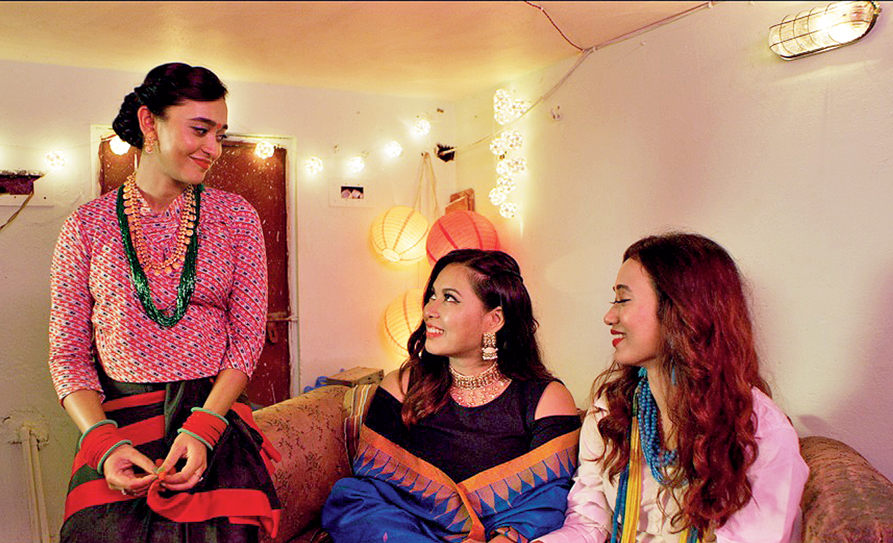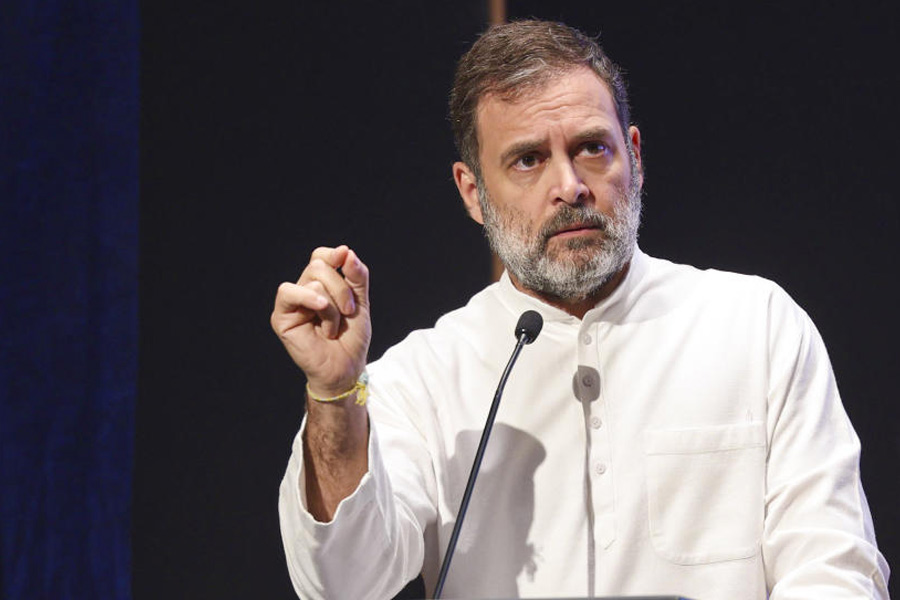After the blockbuster success of Season 2 of Four More Shots Please!, Sayani Gupta is back in a film that explores racial stereotyping and prejudice, but told through humour and food.
Axone (pronounced ‘Akhuni’, named after the fermented soya bean staple typical to some parts of North-east India and known for its pungent smell) is a Hindi film, now streaming on Netflix, that shows a group of friends from the North-east — among them Sayani’s Upasana, a Nepali girl — living in Delhi and pulling out all stops to make the dish to celebrate the wedding of a friend, even as they navigate the treacherous terrain of racism and preconceived notions. Axone is directed by Nicholas Kharkongor and was screened at the Mumbai Film Festival (MAMI) in 2019, besides being feted at festivals outside the country.
The Telegraph chatted with Calcutta girl Sayani on her reasons to do the film, witnessing racism, both serious and casual, and why she isn’t gung-ho about plunging back into shooting anytime soon.
What were your reasons to do Axone?
I had no reasons to not do it, honestly (laughs). Dilip Shankar is the casting director of the film and a very well-respected man in the industry and I always wondered why he never called me. One day, I was going for a shoot and he called and said there was a very good script. I read it and I knew Nick (Nicholas Kharkongor, the director) from before because he’s Kalki’s (Koechlin) friend.
I loved the script and I loved the fact that I had never seen the North-east being represented in our cinema, unless it’s a story from the North-east. I have lots of friends from the North-east, including a film-maker friend, but they either make regional films or smaller independent films which are beautiful, but people don’t know about them or have no access to them. Only once in a while, a film like Aamis (in Assamese) comes along, and that too a lot of people only got to see it when Anurag Kashyap put his weight behind it.
North-east films are still not on a national level. But Axone is a mainstream film. I found the script very authentic and also very funny. Humour is a great way to change minds, and if one talks about serious matters through humour or satire, it tends to make a greater impression and mould more hearts. It’s a very powerful tool, I feel.
You are from Calcutta, and hence closer to the North-east than the rest of the mainland is. Have you seen people hailing from the North-east being subjected to racism and stereotyping?
More than being from Calcutta, I went to college in Delhi! (Laughs) A lot of my classmates and friends were from the North-east. Also, we end up being shallow in referring to it collectively as the North-east because there is so much diversity even between the seven states. I know how a Manipuri is different from a Mizo or someone from Shillong. It’s culturally very different... the food is also very different, and so is the language and dialect. There’s a very funny scene in the film where we get to know so many languages that this bunch of people are speaking at the same time. The film shows how much diversity there is and how little we know about it.
I’ve seen and always been extremely aware of racism... casual racism, serious racism... all of that. People have been violent. Now with the pandemic, there have been so many cases about people calling names... it’s ridiculous! I know for a fact that all my friends from the North-east — and many of those who are part of the cast and are now my friends — have, at some point, felt very angry and very dejected, but have also laughed it off sometimes. There are many levels of racism and it’s really heartbreaking to see how little people know about the North-east. There’s so much ignorance about these states and the people from there.
In this film, food is used as an identity and also to depict the fault line of prejudice but mostly with humour. Do you think the best way to tell the story of Axone was with a lightness of touch?
I think it’s an effective way to say it. Food is huge, historically, not only in our country but across the globe. Food is ever changing, ever evolving. What we believe is ours may not be ours, it could have come from somewhere else. Food has always intrigued me, and also because I studied history.
When it comes to food prejudices, the film is very relevant. And everyone has different prejudices, right? Like I may think, ‘Oh my God! How can anyone eat a rat?!’ Or someone from a vegetarian household could turn around and tell me, ‘How do you eat fish?’, which is my staple. So we are constantly coming from some place of prejudice. Someone like me who literally eats everything would probably have prejudices about some kind of food. My mother makes faces when I eat beef or pork (laughs).
It’s a much longer conversation, honestly. Growing up in Calcutta, I would go to a creche and underneath the creche, there would be some girls from the North-east cooking crab and some other food and I remember my creche aunty constantly cribbing, ‘Oh my God! They are cooking it again! Shut the window!’
Axone is also a friendship story. Upasana , my character, and Chanbi, played by Lin (Laishram), drive the narrative. They do everything possible to make this dish. It’s a comedy of errors, actually. So it’s not just a film about racism, but also a comedy around food. We are calling it a ‘food comedy’. And I think that’s quite a brilliant stroke. It makes the story much more effective and entertaining than just making a dark film about racism because that’s not what Nick was trying to do. He has an inherent sense of humour and that’s what drives the film.
You’ve said that authenticity hooked you to the film. How important do you think was it to cast North-easterners as characters from the North-east? That hasn’t happened, quite controversially, in many films, like Mary Kom, in the past...
Very important. Most of the cast and crew in Axone — probably 98 per cent — were from the North-east. The only people who were not from the region were Vinay Pathak, Dolly Ahluwalia and Rohan Joshi who anyway play north Indians in the film. For my part, I do know that they had considered other actors from the North-east. It just so happened that they liked my audition. And I do look oriental (laughs)... I get that a lot. Everyone kind of thinks I am from the North-east. A lot of people don’t believe I am Bengali.
Growing up, I would go to Darjeeling and Kurseong a lot and most of the locals would only talk to me in Nepali! (Laughs) Since I was a baby, some people would keep calling me, ‘Oh, Bangaalider Jaapani, Bangaalider Jaapani’ and that would really piss me off! (Laughs) The good thing is that I do pass off as a Nepali, or someone from the North-east.
What’s the mindset been like since we spoke about two months ago before the release of Season 2 of Four More Shots Please!? Are you ready to jump back into shooting?
Not at all! I think it’s a really bad idea to start shooting right now. I don’t think we are equipped to handle it. I’ve been watching some videos and it’s quite scary because people are back to flocking together and cramming themselves into buses. I don’t think we have the medical infrastructure to support more cases. I am not shooting anytime soon... I am not even going out of my house! (Laughs) Shooting for Season 3 of Four More Shots... will only happen in September.
We are not saving lives, we are just creating entertainment. If one person at shoot falls sick, the others will have to go into quarantine for two weeks. It’s a case of putting a lot of people in jeopardy. I just don’t feel you can quarantine a set, especially in this country. We are anyway very careless about hygiene. On set, one will have to touch things. You can’t wear a hazmat suit and sit in one corner (laughs)... you will have to expose yourself. I don’t feel it’s safe right now.
How do you see actors navigating shoots in a post-Covid world where you will need to be in close proximity?
We have been talking about it. It doesn’t seem like it’s going to go back to what it was in a hurry. We have to be mindful about touching each other or even taking a glass from someone’s hand, forget about doing intimate scenes or action scenes where you have to touch another person. It’s the first time ever we are all going through something like this and it’s also changed how we perceive intimacy or human interaction. It has to have an effect on how we shoot going forward.
When you make a film or a web series, you are going in to shoot for 90 days, and you don’t know how careful is too careful. We are in a profession that’s least isolated. For now, I am very happy doing jhadoo-pochha-bartan-cooking. I don’t feel like putting make-up on my face anytime soon.










